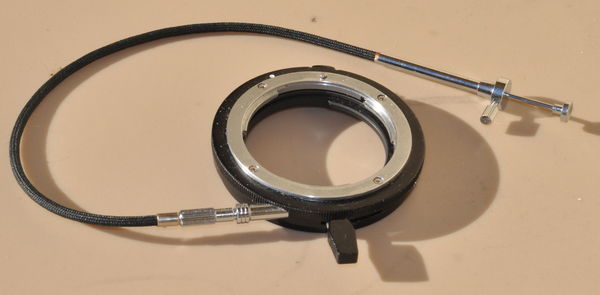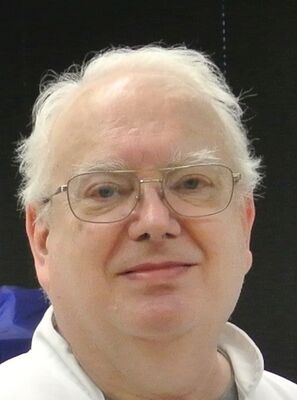Question about using reversed prime lenses.
Dec 2, 2016 10:30:16 #
I am thinking about trying out Johan J Ingles-Le Nobels' idea about making a variable focus length macro lens that can go well over 1:1. See for example here: http://extreme-macro.co.uk/empty-lens/
I won't mind if it does not pan out, but it would be fun just to try, and the whole experiment might be ~ $100. Anyway, the basic idea which is a variant of his idea is to mount a smaller lens, in reverse, onto the end of another electronic focusing lens that has had all of its class removed. So the de-glassed 'proximal' lens still has electrical contact and a functioning aperture, while the glass is in the reversed 'distal' lens. The particular scheme I would like to try, maybe over my Winter vacation, is to take an olde prime lens, and reverse it onto a de-glassed, cheap cheap cheap small zoom kit lens.
My very specific question: I have some 50mm lenses already for the distal lens, but I am wondering if a shorter prime lens, like a 35mm, would give me more magnifying power for some reason. I vaguely remember reading somewhere that shorter reversed lenses are stronger, but am not sure if I read that right.
I won't mind if it does not pan out, but it would be fun just to try, and the whole experiment might be ~ $100. Anyway, the basic idea which is a variant of his idea is to mount a smaller lens, in reverse, onto the end of another electronic focusing lens that has had all of its class removed. So the de-glassed 'proximal' lens still has electrical contact and a functioning aperture, while the glass is in the reversed 'distal' lens. The particular scheme I would like to try, maybe over my Winter vacation, is to take an olde prime lens, and reverse it onto a de-glassed, cheap cheap cheap small zoom kit lens.
My very specific question: I have some 50mm lenses already for the distal lens, but I am wondering if a shorter prime lens, like a 35mm, would give me more magnifying power for some reason. I vaguely remember reading somewhere that shorter reversed lenses are stronger, but am not sure if I read that right.
Dec 2, 2016 11:12:55 #
Dec 2, 2016 11:22:08 #
i use a older film era pentax 50mm on reverse with a reversing ring [ 49mm in this case ] directly on the body , nikon or anything else with the right reversing ring [ ebay / china $ 4.00 ] i tried using a 28mm , it magnify too much , hard to use .all manual there , the focusing ring does nothing , you focus by moving the camera to the subject .a inexpensive ring diode lights [ $ 50 ] makes it easier .you will get with a descent lens sharp close ups .you need to work at f22 for enough deeph???? of field .
Dec 2, 2016 11:43:01 #
melismus
Loc: Chesapeake Bay Country
The diaphragm of a lens is set in one special plane where you can remove outer rays by stopping down, but still get an image that fills the frame. If you set a lens out in front of that plane you will get severe vignetting as you stop down. Back to the drawing board, please.
Dec 2, 2016 14:09:20 #
melismus wrote:
Nobel had written about that issue, but did not encounter a problem with his arrangement. There are other instances where people did something like this, using the proximal lens to provide the diaphragm, only they also kept lenses in the proximal and distal lens. I should keep this issue in mind, but I am not sure that it would be an automatic non-starter.The diaphragm of a lens is set in one special plane where you can remove outer rays by stopping down, but still get an image that fills the frame. If you set a lens out in front of that plane you will get severe vignetting as you stop down. Back to the drawing board, please.
Dec 3, 2016 14:33:48 #
Fotodiox makes reversing rings for both Canon and Nikon mounts that include cables for the circuitry that lets you use the aperture and focus capabilities of the lens, I've been playing with the Canon one, and it works OK on a tripod or stand mount, but I think I'm going to be buying a 100-105 mm macro lens at some point anyway, because it will give me more flexibility in the field.
Dec 3, 2016 15:09:43 #
Yes, I know about those. They are a neat trick. From what I had seen, though, the piece that goes in front takes up additional space between the lens and the subject so the effective working distance is less. It would scare off some of the critters, so I decided against it.
Dec 3, 2016 16:30:23 #
You did not mention what gear are using but nikon makes mounts for reversing lenses for more than 1:1 magnification. Yes, the wider the lens, the greater the magnification, is a true statement. One of the best lenses ever made for being reversed is the Nikon 50mm f1.8 lens.
Dec 3, 2016 17:36:13 #
whitewolfowner wrote:
Canon. I do not know if this is a viable scheme anyway (and maybe not), but the reversal in this scheme would be by mounting two lenses face to face, with an adapter that attaches them by their filter rings. This is done for example where both lenses keep all of their glass and the proximal lens still communicates w/ the camera. You did not mention what gear are using but nikon makes mounts for reversing lenses for more than 1:1 magnification. Yes, the wider the lens, the greater the magnification, is a true statement. One of the best lenses ever made for being reversed is the Nikon 50mm f1.8 lens.
What do you mean by 'the wider the lens the greater the mag.'? So a reversed 50mm gives more mag than say, a reversed 35mm?
Dec 3, 2016 18:18:23 #
whitewolfowner wrote:
Yes, and the Nikon 50mm f1.8 is inexpensive. The BR-2 is the reversing adapter I use, it has 52mm threads, which makes it useful for longer 52mm extension tubes also.You did not mention what gear are using but Nikon makes mounts for reversing lenses for more than 1:1 magnification. Yes, the wider the lens, the greater the magnification, is a true statement. One of the best lenses ever made for being reversed is the Nikon 50mm f1.8 lens.
Dec 3, 2016 18:18:34 #
Mark Sturtevant wrote:
No, its the other way around. A reversed 35mm will produce a larger image that a reversed 50mm lens. What I'm referring to is a system where you use one lens and reverse it. Putting two lenses together like that, I would think would kill the amount of light going to the sensor and cause all other kinds of optical problems too. Yes, it will be all manually controlled wit the settings and focus but that is usually the way its done in macro anyways.What do you mean by 'the wider the lens the greater the mag.'? So a reversed 50mm gives more mag than say, a reversed 35mm?
Dec 3, 2016 18:26:15 #
Mark Sturtevant wrote:
Have you looked into placing a reversed lens on a longer lens. In this case you get the magnification ratio of the two lens, for example 50mm reversed on a 105mm gives about 2X (105/50). If you check out Johan's site you mentioned he has some examples.. . . but the reversal in this scheme would be by mounting two lenses face to face, with an adapter that attaches them by their filter rings.
I will be soon trying the Rokinon/Samyang 135mm f2 manual focus with a 50mm f1.8 reversed, as well as the 135mm acting as a "relay lens" for microscope objectives.
Dec 3, 2016 18:30:27 #
Read FAQ: Differences between Reverse-Mounted and Stacked-Lenses for Macro-Photography? at http://www.uglyhedgehog.com/t-90623-1.html
I have a Nikon BR-6 and a standard cable release available for purchase.
I have a Nikon BR-6 and a standard cable release available for purchase.

Dec 4, 2016 01:55:33 #
whitewolfowner wrote:
I agree, in that stacking two lenses together like that is putting a lot of glass into the light path. It is not worth it, except as a low-cost way to enter macrophotog. I am past that.What I'm referring to is a system where you use one lens and reverse it. Putting two lenses together like that, I would think would kill the amount of light going to the sensor and cause all other kinds of optical problems too.
Dec 4, 2016 02:03:16 #
Nikonian72 wrote:
If I understand, this would be helpful for a staged shot, and maybe with a camera mounted on a tripod or stand. Most of what I do is outdoors, however. I have a Nikon BR-6 and a standard cable release available for purchase.
Thanks again, people, for your interesting suggestions!
If you want to reply, then register here. Registration is free and your account is created instantly, so you can post right away.





